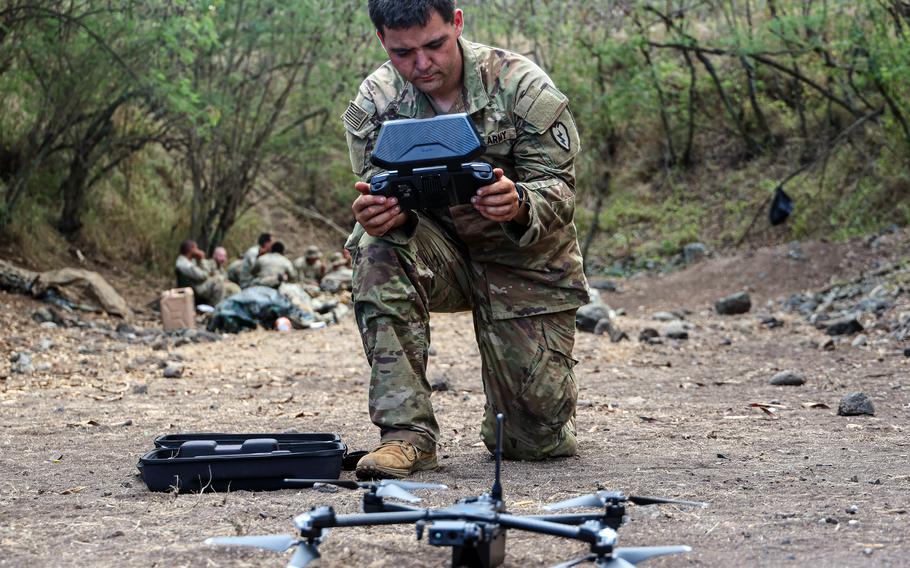
Army Spc. Brendan Nicholas, an infantryman assigned to the 25th Infantry Division, prepares to launch a Skydio X10D drone at Schofield Barracks, Hawaii, on Oct. 5, 2024, during a Joint Pacific Multinational Training Center exercise. (Brenden Delgado/U.S. Army)
The Army is using its new troop-moving vehicle and small drones to create smaller, more mobile reconnaissance and strike teams, dubbed by some as hunter-killer platoons, according to the commander of the Hawaii-based 25th Infantry Division.
Those light units possess highly “organic” see-sense-strike capabilities, qualities employed in the culminating scenario of a massive two-week exercise in Hawaii that ended Thursday, Maj. Gen. Marcus Evans said by phone Monday during a media roundtable from the Philippines.
Central to that desired agility is the Army’s new Infantry Squad Vehicle that allows small formations of soldiers to transit the battle space more nimbly and with greater stealth.
Almost 100 of the new vehicles were used during the recent exercise.
“It has really provided the formation the ability to move at night over different distances, to be able to become really small, and then to come back together to mass formations at the appropriate place and time,” Evans said.
“The reason that’s important is, based on the lessons that we are seeing out of Ukraine, it is important to be extremely agile, while at the same time being very small, which in turn makes you less targetable, and then being able to come together as a fighting formation at a particular time,” said Evans, who was joined on the call by division Command Sgt. Maj. Shaun Curry.
They were in the Philippines to commemorate the 80th anniversary of the country’s liberation in 1944 from Japanese occupation and to begin planning joint army exercises for 2025.
The new squad vehicle, designed to carry nine soldiers, is manufactured by GM Defense, a subsidiary of General Motors.
It is based on the Chevrolet Colorado ZR2 Bison and powered by a 2.8-liter engine. It is quiet, fuel-efficient and small enough to be loaded into a Chinook or Stallion helicopter and light enough to be sling-loaded under a Black Hawk helicopter, according to an Army fact sheet.
The squad vehicles are part of the Army’s “Transforming in Contact” initiative, which aims to rapidly put the newest technology into the hands of soldiers to make them more lethal, survivable and adaptable in any environment.
The concept is being tested using brigade combat teams with the 25th, 101st Airborne and 10th Mountain divisions, according to an Army fact sheet.
The service is in the process of validating the new squad vehicles, by which equipment is tested and evaluated to confirm it meets performance and safety standards before being fully deployed.
As part of the Transforming in Contact initiative, about 130 short-range reconnaissance drones were used during the Hawaii exercise, Evans said.
“What that provides is the ability to see farther than an organic rifle platoon or rifle company has been able to see in the past — with assets that they control,” he said. “So, generally, they can see up to about three kilometers and be able to inform how they maneuver and gain positions of advantage.”
The squad vehicles and drones “have increased the overall lethality of the formation, as well as the survivability,” an outcome witnessed during the culminating event of the Hawaii exercise, he said.
“What we were able to see on the final attack were these small elements that were able to infiltrate either on Infantry Squad Vehicles or a combination of rotary-wing aircraft and identify enemy nodes or enemy capabilities such as a counterattack force through their employment of [unmanned aerial vehicles],” he said.
They could then “enable a strike solution that supported the overall brigade,” he said.
“So, when you combine seeing, sensing and striking in a very small and equally important agile formation, it creates opportunities to gain positions of advantage for the maneuvering forces,” Evans said.